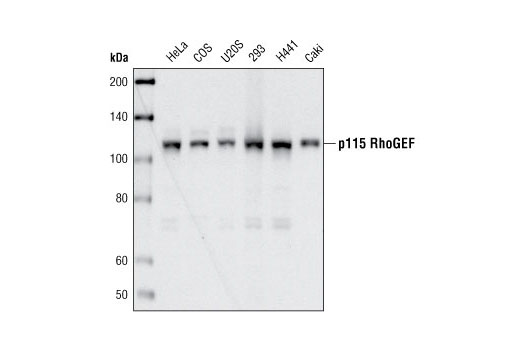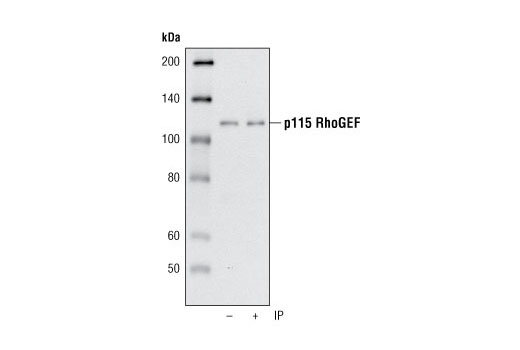WB, IP, IF-IC
H M R Mk
Endogenous
115
Rabbit
#Q92888
9138
Product Information
Product Usage Information
| Application | Dilution |
|---|---|
| Western Blotting | 1:1000 |
| Immunoprecipitation | 1:50 |
| Immunofluorescence (Immunocytochemistry) | 1:50 |
Storage
Specificity / Sensitivity
Species Reactivity:
Human, Mouse, Rat, Monkey
Source / Purification
Monoclonal antibody is produced by immunizing animals with a synthetic peptide corresponding to residues near the amino terminus of human p115 RhoGEF.
Background
The Rho family small GTPases, including Rho, Rac and cdc42, act as molecular switches, regulating processes such as cell migration, adhesion, proliferation and differentiation. They are activated by guanine nucleotide exchange factors (GEFs), which catalyze the exchange of bound GDP for GTP, and inhibited by GTPase activating proteins (GAPs), which catalyze the hydrolysis of GTP to GDP. A third level of regulation is provided by the stoichiometric binding of Rho GDP dissociation inhibitor (RhoGDI) (1).
G-protein coupled receptors (GPCRs) at the cell surface signal through heteromeric G proteins to small GTPases such as Rho, which then signal to downstream effector molecules (2). p115 RhoGEF/ArhGEF1 and its family members PDZ-RhoGEF (PRG), and LARG are stimulated by heteromeric G proteins and thus couple signaling from GPCRs to Rho small GTPases (3-6). In a mouse model of asthma, p115 RhoGEF is necessary for T cells to enable airway inflammation and hyperreactivity (7).
- DerMardirossian, C. and Bokoch, G.M. (2005) Trends Cell Biol 15, 356-63.
- Morris, A.J. and Malbon, C.C. (1999) Physiol Rev 79, 1373-430.
- Chen, Z. et al. (2003) J Biol Chem 278, 9912-9.
- Hart, M.J. et al. (1998) Science 280, 2112-4.
- Kozasa, T. et al. (1998) Science 280, 2109-11.
- Bhattacharyya, R. and Wedegaertner, P.B. (2003) Biochem J 371, 709-20.
- Brown, J.P. et al. (2007) Am J Respir Crit Care Med 176, 10-9.
Species Reactivity
Species reactivity is determined by testing in at least one approved application (e.g., western blot).
Western Blot Buffer
IMPORTANT: For western blots, incubate membrane with diluted primary antibody in 5% w/v BSA, 1X TBS, 0.1% Tween® 20 at 4°C with gentle shaking, overnight.
Applications Key
WB: Western Blotting IP: Immunoprecipitation IF-IC: Immunofluorescence (Immunocytochemistry)
Cross-Reactivity Key
H: human M: mouse R: rat Hm: hamster Mk: monkey Vir: virus Mi: mink C: chicken Dm: D. melanogaster X: Xenopus Z: zebrafish B: bovine Dg: dog Pg: pig Sc: S. cerevisiae Ce: C. elegans Hr: horse GP: Guinea Pig Rab: rabbit All: all species expected
Trademarks and Patents
Limited Uses
Except as otherwise expressly agreed in a writing signed by a legally authorized representative of CST, the following terms apply to Products provided by CST, its affiliates or its distributors. Any Customer's terms and conditions that are in addition to, or different from, those contained herein, unless separately accepted in writing by a legally authorized representative of CST, are rejected and are of no force or effect.
Products are labeled with For Research Use Only or a similar labeling statement and have not been approved, cleared, or licensed by the FDA or other regulatory foreign or domestic entity, for any purpose. Customer shall not use any Product for any diagnostic or therapeutic purpose, or otherwise in any manner that conflicts with its labeling statement. Products sold or licensed by CST are provided for Customer as the end-user and solely for research and development uses. Any use of Product for diagnostic, prophylactic or therapeutic purposes, or any purchase of Product for resale (alone or as a component) or other commercial purpose, requires a separate license from CST. Customer shall (a) not sell, license, loan, donate or otherwise transfer or make available any Product to any third party, whether alone or in combination with other materials, or use the Products to manufacture any commercial products, (b) not copy, modify, reverse engineer, decompile, disassemble or otherwise attempt to discover the underlying structure or technology of the Products, or use the Products for the purpose of developing any products or services that would compete with CST products or services, (c) not alter or remove from the Products any trademarks, trade names, logos, patent or copyright notices or markings, (d) use the Products solely in accordance with CST Product Terms of Sale and any applicable documentation, and (e) comply with any license, terms of service or similar agreement with respect to any third party products or services used by Customer in connection with the Products.


